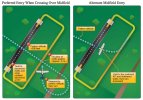PaulS
Touchdown! Greaser!
I think the Cirrus thought he would get ahead of you in the downwind, he probably was coming in fast for that reason, kind of a dumb plan. In a G5 or newer he could slow down quickly by putting in flaps, the older Cirrus are tougher to slow down. Were it me in the Cirrus position seeing it might be close, I would do a 360, give the 150 time to get out of the way, then continue. It would have cost him 2 minutes.
On the other hand for the 150, he could have just extended the up wind or the crosswind to deconflict. The issue is determining there will be a conflict. You would think that the Cirrus calling 8 miles out would give you plenty of time for your pattern, but depending on conditions he could have been going 180 knots. Cirrus recommends entering the pattern at 120 knots or less. It sounds like he was going much faster, which he probably could have communicated much sooner, as in the first time he heard the 150 might be a conflict. He could have said "Hey 150, I'm coming in hot here, any chance you could extend for me, not sure I can slow down in time." A little extra communication goes a long way.
I don't think either of you were at fault, but the crass comment from the Cirrus guy makes me think he is a believer in the "big sky" method of traffic avoidance and he believes a bigger, faster plane is going to fare better in a midair than a 150. Not smart things to believe in.
On the other hand for the 150, he could have just extended the up wind or the crosswind to deconflict. The issue is determining there will be a conflict. You would think that the Cirrus calling 8 miles out would give you plenty of time for your pattern, but depending on conditions he could have been going 180 knots. Cirrus recommends entering the pattern at 120 knots or less. It sounds like he was going much faster, which he probably could have communicated much sooner, as in the first time he heard the 150 might be a conflict. He could have said "Hey 150, I'm coming in hot here, any chance you could extend for me, not sure I can slow down in time." A little extra communication goes a long way.
I don't think either of you were at fault, but the crass comment from the Cirrus guy makes me think he is a believer in the "big sky" method of traffic avoidance and he believes a bigger, faster plane is going to fare better in a midair than a 150. Not smart things to believe in.

